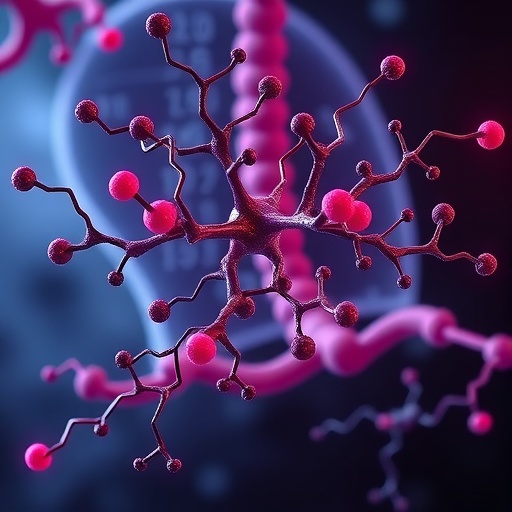A Breakthrough in Tuberculosis Treatment: Sustained Inhibition of Purine Biosynthesis Yields Promising In Vivo Results
Tuberculosis (TB) remains a formidable global health challenge, complicated by rising drug resistance and the long, complex regimens currently required for effective therapy. Researchers have long sought novel targets within the Mycobacterium tuberculosis (Mtb) metabolic pathways to develop treatments that can shorten therapy duration and overcome resistance. In a pioneering study recently published in Nature, Lamprecht, Wall, Leemans, and colleagues unveil compelling evidence supporting the de novo purine biosynthesis enzyme PurF as a viable drug target, with their molecule JNJ-6640 demonstrating significant in vivo efficacy through innovative delivery methods.
The journey toward validating PurF as a therapeutic target began with the promising bactericidal activity of JNJ-6640 observed in vitro. However, the transition from bench to bedside requires rigorous confirmation that the compound selectively inhibits the bacterial orthologue without adverse effects on human enzymes. Equally imperative was the establishment of in vivo efficacy to translate molecular promise into clinical potential. This milestone was approached with meticulous pharmacokinetic profiling and innovative formulation strategies.
Initial absorption, distribution, metabolism, and excretion (ADME) studies revealed that JNJ-6640 undergoes rapid metabolism, exhibiting high intrinsic clearance in liver microsomes and hepatocytes. Moreover, the compound displayed inhibitory effects on certain cytochrome P450 (CYP) enzymes, a key consideration given the potential for drug-drug interactions. Although this rapid metabolism suggested a possible challenge in maintaining therapeutic plasma concentrations, subsequent in vivo studies in mice demonstrated that while the half-life was brief—approximately 0.76 hours—the predicted rapid clearance seen in vitro did not perfectly translate in the living organism.
The physicochemical characteristics of JNJ-6640, including its low aqueous solubility, presented additional hurdles for achieving sustained plasma levels through conventional oral or intravenous routes. To circumvent these challenges, the research team innovated a long-acting injectable (LAI) formulation based on an aqueous suspension. LAI systems, known for their capacity to provide continuous and controlled drug release, offered a strategic advantage in maintaining therapeutically effective concentrations over prolonged periods without repeated dosing.
Pharmacokinetic analyses of mice administered a subcutaneous injection of the LAI at 1,500 mg/kg confirmed sustained systemic exposure of JNJ-6640 for at least four weeks. Impressively, this mode of delivery was well tolerated; throughout the study’s duration, mice exhibited no adverse clinical signs or significant changes in body weight. These findings were pivotal in establishing that the LAI approach not only optimizes pharmacodynamics but also ensures safety and tolerability necessary for in vivo proof-of-concept studies.
To translate these pharmacokinetic and safety successes into functional efficacy, the researchers employed two mouse models of tuberculosis infection. In an acute infection model, mice inoculated with 200 colony-forming units (CFU) of Mtb were administered one or two weekly doses of the JNJ-6640 LAI formulation. Notably, two doses induced a remarkable 1.8 log reduction in bacterial burden compared to vehicle controls, while a single dose yielded a statistically significant but more modest reduction, highlighting a clear dose-response relationship.
Further validating their findings, the team assessed efficacy in a chronic infection model, which mimics the long-term nature and complexity of human TB disease. Here, weekly administration of 1,500 mg/kg JNJ-6640 LAI over eight weeks resulted in a significant 0.5 log CFU reduction relative to controls. This sustained suppression of bacterial loads in a protracted infection context firmly establishes PurF inhibition as a powerful mechanism for combatting persistent Mtb infection.
These results collectively mark a pivotal step forward in tuberculosis therapeutic development. The ability to maintain effective drug exposure over weeks through a single injection offers a transformative advantage, potentially facilitating shorter, more manageable treatment courses and improving patient adherence. Moreover, targeting metabolic pathways such as purine biosynthesis, hitherto underutilized in TB drug discovery, expands the mechanistic landscape for future antimycobacterial agents.
Importantly, the study underscores the nuanced challenges that can emerge during drug development—from rapid metabolism and solubility barriers to complex pharmacokinetic profiles requiring innovative formulation solutions. The strategic deployment of LAI formulations here exemplifies a paradigm shift in addressing these hurdles, optimizing the pharmacological utility of compounds with otherwise limited systemic persistence.
Beyond the compound’s direct activity, the selective targeting of the bacterial PurF orthologue over human homologues further mitigates concerns of off-target toxicity, addressing a critical consideration in antimicrobial drug design. Such selectivity fosters a therapeutic window that can maximize efficacy while minimizing adverse effects, an essential factor for drugs destined for global use, especially in resource-limited settings.
While these preclinical findings are encouraging, translating this approach to humans will necessitate further investigation into optimal dosing, potential immunogenicity of the formulation, and long-term safety. Moreover, comprehensive assessment against drug-resistant Mtb strains will determine JNJ-6640’s clinical scope as standalone therapy or part of combination regimens.
Nevertheless, this breakthrough study elegantly illustrates how targeting fundamental bacterial metabolic processes coupled with innovative drug delivery technologies can surmount historic obstacles in infectious disease treatment. It opens exciting avenues not only for tuberculosis but potentially other persistent bacterial infections where sustained drug exposure and novel mechanism action are paramount.
As global health systems grapple with the burdens of tuberculosis amidst shifting epidemiological landscapes, advances like these kindle hope for more effective, patient-friendly therapies that can turn the tide against this age-old scourge. JNJ-6640 and its compelling demonstration of in vivo efficacy via PurF inhibition stand as a testament to the future of targeted antimicrobial innovation.
Subject of Research: PurF enzyme inhibition in Mycobacterium tuberculosis as a therapeutic strategy
Article Title: Targeting de novo purine biosynthesis for tuberculosis treatment
Article References: Lamprecht, D.A., Wall, R.J., Leemans, A. et al. Targeting de novo purine biosynthesis for tuberculosis treatment. Nature (2025). https://doi.org/10.1038/s41586-025-09177-7
Image Credits: AI Generated




